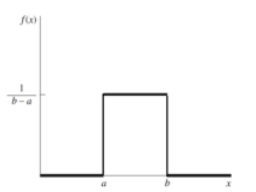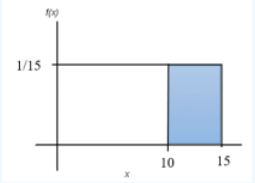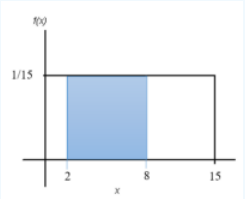6.2: Uniform Distribution
- Page ID
- 24044
The continuous uniform distribution models the probability that is the same on an interval from a to b. We use the following probability density function (PDF) to graph a straight line.
f(x)= \(\begin{cases}\frac{1}{b-a}, & \text { for } a \leq x \leq b \\ 0, & \text { elsewhere }\end{cases}\)
The probability is found by taking the area between two points within the rectangle formed from the x-axis, between the endpoints a and b, the length, and f(x) = 1/(b-a), the height. When working with continuous distributions it is helpful to draw a picture of the distribution, then shade in the area of the probability that you are trying to find. See Figure 6-5.

Figure 6-5
If a continuous random variable X has a uniform distribution with starting point a and ending point b then the distribution is denoted as X~U(a,b).
Area of a Rectangle = length*height
To find the probability (area) under the uniform distribution, use the following formulas.
- \(\mathrm{P}(X \geq x)=\mathrm{P}(X>x)=\left(\frac{1}{b-a}\right) \cdot(b-x)\)
- \(\mathrm{P}(X \leq x)=\mathrm{P}(X<x)=\left(\frac{1}{b-a}\right) \cdot(x-a)\)
- \(\mathrm{P}\left(x_{1} \leq X \leq x_{2}\right)=\mathrm{P}\left(x_{1}<X<x_{2}\right)=\left(\frac{1}{b-a}\right) \cdot\left(x_{2}-x_{1}\right)\)
The arrival time between trains at a train stop is uniformly distributed between 0 and 15 minutes. A student does not check the schedule and has arrived at the train stop.
- Compute the probability they wait more than 10 minutes.
- Compute the probability of waiting between 2 and 8 minutes.
Solution
a) First plug in the endpoints a = 0 and b = 15 into the PDF to get the height of the rectangle. The height is f(x)= \(\frac{1}{15-0}=\frac{1}{15}\). Draw and label the distribution with the a, b and the height as in Figure 6- 6. The probability is the area of the shaded rectangle P(X > 10). Draw a vertical line at x = 10. We want x values that are greater than 10, so shade the area to the right of 10, stopping at b = 15. To find the area of the shaded rectangle in Figure 6-6, we can take the length times the height. The length would be b – a = 15 – 10 = 5 and the height is f(x) = 1/15.

Figure 6-6
The area of the shaded rectangle is 5 (\(\frac{1}{15}\)) = \(\frac{1}{3}\) = 0.3333 or P(X > 10) = 0.3333, which is the probability of waiting more than 10 minutes. Note that this would be the same if we asked P(X ≥ 10) = 0.3333 since there is no area at the line X = 10.
b) The area will be length times height. Draw the picture and shade the rectangle between 2 and 8, see Figure 6-7. The length is b – a = 8 – 2 = 6 and the height is still f(x) = 1/15. P(2 ≤ X ≤ 8) = 6(\(\frac{1}{15}\)) = 0.4

Figure 6-7


